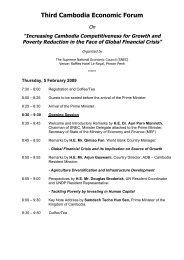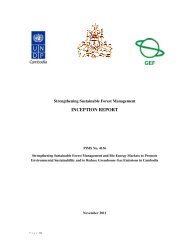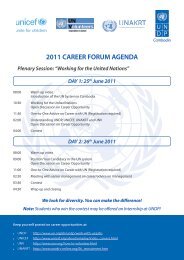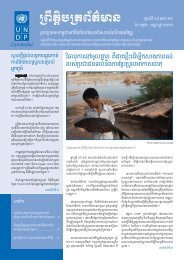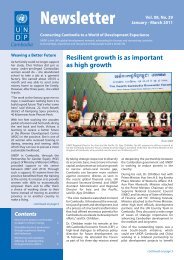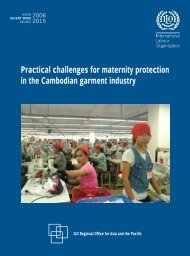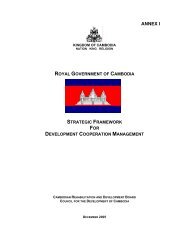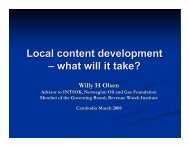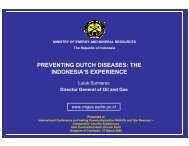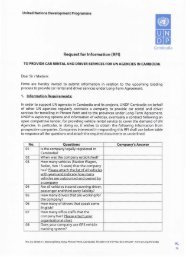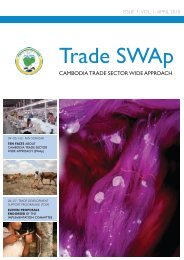UN Analysis Final.pdf - United Nations in Cambodia
UN Analysis Final.pdf - United Nations in Cambodia
UN Analysis Final.pdf - United Nations in Cambodia
Create successful ePaper yourself
Turn your PDF publications into a flip-book with our unique Google optimized e-Paper software.
BOX: 4.1 FOCUS OF ESSP 2006- 2010<br />
The ESSP lays out policy priorities that<br />
diverge from previous policy formulations<br />
for basic education <strong>in</strong> three ma<strong>in</strong> respects:<br />
<strong>in</strong>creased emphasis on demand-side<br />
<strong>in</strong>terventions<br />
greater importance placed on<br />
improv<strong>in</strong>g education quality<br />
stronger focus on lower secondary<br />
education<br />
These efforts notwithstand<strong>in</strong>g, access to education is<br />
still geographically limited and is shaped by wealth<br />
status. Rural youth and other <strong>in</strong>digent populations<br />
of young people are still most likely to be excluded.<br />
Additionally, the quality of education still needs to be<br />
standardized to meet <strong>in</strong>ternational criteria.<br />
4.1.2 EDUCATION EXPENDITURE AND SUPPORT<br />
A critical factor <strong>in</strong> achiev<strong>in</strong>g poverty reduction through<br />
education and ensur<strong>in</strong>g wider access has been a<br />
significantly <strong>in</strong>crease <strong>in</strong> education’s recurrent budget<br />
share <strong>in</strong> recent years. The <strong>in</strong>crease has generally been seen<br />
to be more pro-poor and to some extent well distributed.<br />
Government spend<strong>in</strong>g on education doubled from the<br />
1990s reach<strong>in</strong>g 18.9 per cent <strong>in</strong> 2006. The World Bank<br />
(2006) suggests that this prioritized government spend<strong>in</strong>g<br />
has resulted <strong>in</strong> the balance of benefit accru<strong>in</strong>g to the poor.<br />
Due to MoEYS <strong>in</strong>vestment <strong>in</strong> school facilities and <strong>in</strong>structional materials over the past several years, a notable<br />
transformation has taken place <strong>in</strong> various levels of education. Systems performance, however, varies widely<br />
across regions <strong>in</strong> terms of quality, efficiency and coverage 17 . National data on education sector performance<br />
<strong>in</strong>dicates that improvements <strong>in</strong> primary and secondary completion are still <strong>in</strong>sufficient and that more effort is<br />
required to reach the target <strong>in</strong>dicator by 2015. This poses a major challenge for <strong>Cambodia</strong>, especially <strong>in</strong> terms<br />
of ma<strong>in</strong>ta<strong>in</strong><strong>in</strong>g the ga<strong>in</strong>s achieved at the younger grades while expand<strong>in</strong>g capacity <strong>in</strong> the middle school years,<br />
for as primary school capacity <strong>in</strong>creases, so too will demand at the secondary school level. Additionally, while<br />
expanded capacity is critical, so is assur<strong>in</strong>g the quality of education.<br />
On recognis<strong>in</strong>g the requirement for human capital <strong>in</strong> response to economic and social development,<br />
stakeholders have made major efforts and <strong>in</strong>vestment <strong>in</strong> education, and promoted access to education for<br />
young people (Table 4-1).<br />
Table 4-1. Trends <strong>in</strong> education support from development partners to the sub-sector<br />
Education Sector<br />
2007 2008 2009 2010<br />
USD ‘000<br />
Non-Formal and General Education Development 26,020 36,299 26,877 20,746<br />
Tra<strong>in</strong>ed Educational Development on Technical, Higher<br />
Education and Scientific Research<br />
6,837 6,235 5,596 2,933<br />
Youth and Sport Development 2.749 2,651 331 331<br />
Strengthen<strong>in</strong>g Good Governance 97 244 14 14<br />
Education Service Management and Support 3,181 2,671 428 195<br />
Other 5,721 11,053 1,286 540<br />
Total Expenditure from Development Partners 44,605 59,153 34,514 24,760<br />
Source: MoEYS 2008<br />
17<br />
For CSES 2004, <strong>Cambodia</strong> was geographically divided <strong>in</strong>to four major natural endowment zones: the ‘Pla<strong>in</strong>s’ area<br />
(Phnom Penh, Kandal, Kompong Cham, Svay Rieng, Prey veng and Takeo) Tonle Sap area, the coastal zone; and the plateau zone.<br />
40 Situation <strong>Analysis</strong> of Youth <strong>in</strong> <strong>Cambodia</strong>




